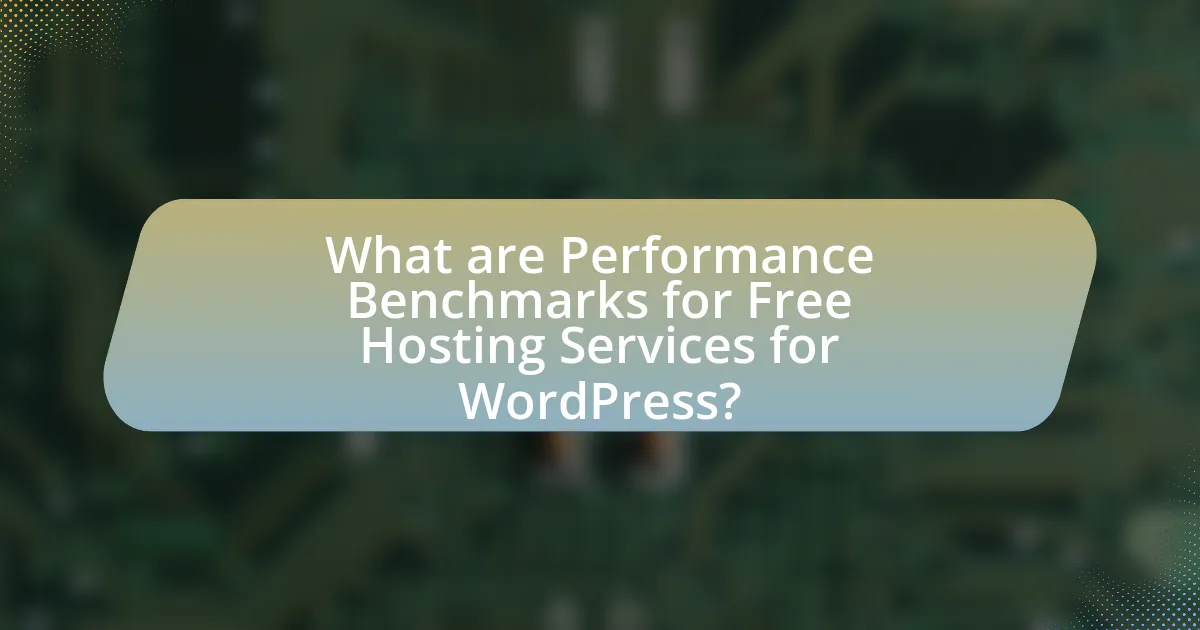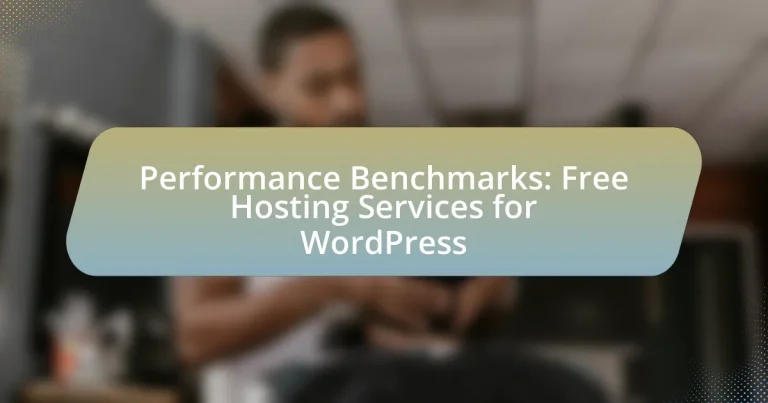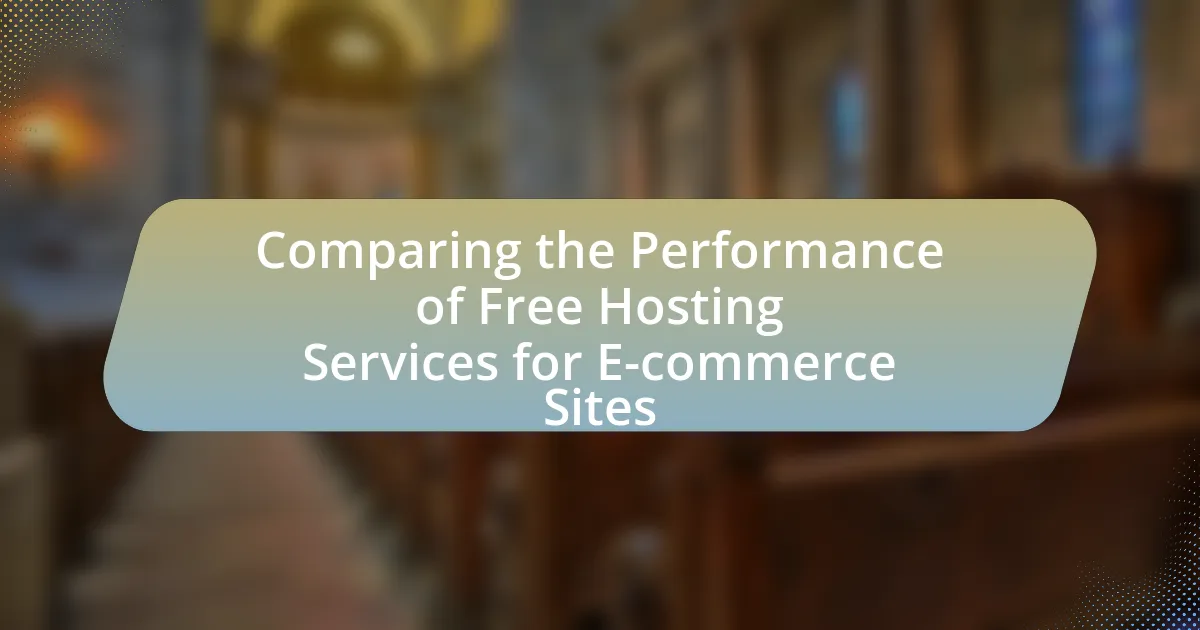Performance benchmarks for free hosting services for WordPress are critical metrics that include uptime, page load speed, and resource allocation. These benchmarks reveal that free hosting typically offers lower uptime rates and slower page load speeds compared to paid services, making them suitable primarily for small personal sites or testing. The article examines how these performance metrics are measured, their impact on user experience, and the importance of evaluating hosting services against established benchmarks. Additionally, it discusses the risks associated with choosing free hosting without proper evaluation and provides guidance on selecting the right service based on performance indicators. Key factors affecting performance, types of free hosting services, and best practices for optimizing performance are also explored.

What are Performance Benchmarks for Free Hosting Services for WordPress?
Performance benchmarks for free hosting services for WordPress typically include metrics such as uptime, page load speed, and resource allocation. For instance, many free hosting services offer uptime rates around 99.5%, which is lower than paid services that often guarantee 99.9% or higher. Page load speeds for free hosting can average between 2 to 5 seconds, while optimal load times for user experience should ideally be under 2 seconds. Additionally, free hosting services often limit CPU and RAM usage, which can affect performance during high traffic periods. These benchmarks indicate that while free hosting can be suitable for small personal sites or testing, it may not meet the performance needs of larger or more professional WordPress sites.
How are performance benchmarks measured in free hosting services?
Performance benchmarks in free hosting services are measured through metrics such as uptime, response time, load time, and resource allocation. These metrics are typically assessed using monitoring tools that track server performance over time, providing data on how quickly websites load and how reliably they remain accessible. For instance, a common benchmark for uptime is 99.9%, indicating that the service is operational almost all the time. Response time is often measured in milliseconds, with lower values indicating better performance. Load time is critical for user experience, with studies showing that a delay of just one second can lead to a significant drop in user satisfaction and engagement. Resource allocation, including CPU and memory limits, is also evaluated to determine how well the service can handle traffic and resource demands.
What metrics are commonly used to evaluate performance benchmarks?
Common metrics used to evaluate performance benchmarks include response time, uptime, load time, and throughput. Response time measures how quickly a server responds to a request, typically aiming for under 200 milliseconds for optimal performance. Uptime indicates the percentage of time a service is operational, with a benchmark of 99.9% being standard for reliable hosting. Load time assesses how long it takes for a webpage to fully render, with a target of under 3 seconds for user satisfaction. Throughput measures the number of requests a server can handle in a given time frame, often expressed in requests per second, with higher values indicating better performance. These metrics are essential for assessing the effectiveness and reliability of hosting services, particularly for WordPress sites.
How do these metrics impact user experience on WordPress sites?
Metrics such as page load time, uptime, and server response time significantly impact user experience on WordPress sites. A faster page load time enhances user satisfaction, as studies show that a one-second delay can lead to a 7% reduction in conversions. Uptime is crucial; a site that is frequently down frustrates users and can lead to loss of traffic and trust. Additionally, server response time affects how quickly content is delivered, with optimal response times being under 200 milliseconds to maintain user engagement. These metrics collectively determine how users interact with a site, influencing their likelihood to return and recommend the site to others.
Why are performance benchmarks important for WordPress users?
Performance benchmarks are important for WordPress users because they provide measurable data on website speed, reliability, and resource usage. These metrics enable users to assess the performance of their hosting services, ensuring that their websites load quickly and efficiently, which is crucial for user experience and search engine rankings. For instance, studies show that a one-second delay in page load time can lead to a 7% reduction in conversions. By utilizing performance benchmarks, WordPress users can make informed decisions about their hosting options, optimizing their sites for better performance and ultimately enhancing their online presence.
What risks do users face when choosing free hosting services without benchmarks?
Users face significant risks when choosing free hosting services without benchmarks, including unreliable performance, security vulnerabilities, and lack of customer support. Unreliable performance can lead to slow loading times and frequent downtime, negatively impacting user experience and search engine rankings. Security vulnerabilities arise from inadequate protection measures, making websites susceptible to hacking and data breaches. Additionally, the absence of customer support can leave users without assistance during critical issues, further jeopardizing their website’s functionality and security. These risks highlight the importance of evaluating hosting services against established benchmarks to ensure reliability and safety.
How can performance benchmarks guide users in selecting the right hosting service?
Performance benchmarks can guide users in selecting the right hosting service by providing quantifiable metrics that compare the speed, uptime, and resource allocation of different hosting options. These benchmarks allow users to assess how well a hosting service performs under various conditions, such as traffic loads and server response times. For instance, a study by HostingAdvice found that services with higher uptime percentages, typically above 99.9%, significantly enhance website reliability, which is crucial for user experience and SEO rankings. By analyzing these performance metrics, users can make informed decisions that align with their specific needs, ensuring they choose a hosting service that offers optimal performance for their WordPress sites.

What are the key factors affecting performance benchmarks in free hosting services?
The key factors affecting performance benchmarks in free hosting services include server speed, resource allocation, uptime reliability, and customer support. Server speed is crucial as it directly impacts loading times; for instance, studies show that a one-second delay can reduce conversions by 7%. Resource allocation, which encompasses CPU, RAM, and bandwidth, determines how many users can be served simultaneously without degradation in performance. Uptime reliability is essential, with a benchmark of 99.9% uptime being standard for quality hosting; free services often fall short of this, leading to potential downtime. Lastly, customer support can influence performance indirectly, as timely assistance can resolve issues that affect service quality.
How does server location influence performance benchmarks?
Server location significantly influences performance benchmarks by affecting latency, bandwidth, and data transfer speeds. When servers are geographically closer to users, the time it takes for data to travel decreases, resulting in faster load times and improved user experience. For instance, a study by Google found that a 100-millisecond delay in load time can decrease conversions by 7%. Additionally, servers located in regions with robust infrastructure can provide higher bandwidth and more reliable connections, further enhancing performance metrics. Therefore, the strategic placement of servers is crucial for optimizing performance benchmarks in web hosting services.
What role does server speed play in overall performance?
Server speed is crucial for overall performance as it directly affects the loading time of websites and applications. Faster servers process requests more quickly, leading to reduced latency and improved user experience. Studies show that a one-second delay in server response time can lead to a 7% reduction in conversions, highlighting the importance of speed in retaining users and maximizing engagement. Additionally, search engines like Google consider page speed as a ranking factor, meaning that faster servers can enhance visibility and traffic.
How does bandwidth allocation affect website loading times?
Bandwidth allocation directly impacts website loading times by determining the amount of data that can be transmitted to users within a given timeframe. When a website has limited bandwidth, it can lead to slower loading times, especially during peak traffic periods, as the server struggles to deliver content efficiently. For instance, a study by Google found that a one-second delay in loading time can result in a 20% decrease in conversions, highlighting the critical role of bandwidth in user experience. Therefore, adequate bandwidth allocation is essential for maintaining optimal loading speeds and ensuring a positive interaction with the website.
What types of free hosting services are available for WordPress?
There are several types of free hosting services available for WordPress, including shared hosting, managed WordPress hosting, and website builders with WordPress integration. Shared hosting allows multiple users to host their websites on a single server, which is cost-effective but may lead to slower performance due to resource sharing. Managed WordPress hosting specifically optimizes the server environment for WordPress, offering features like automatic updates and enhanced security, although free options may have limitations. Website builders like WordPress.com provide a user-friendly interface for creating WordPress sites without needing technical skills, but they often come with restrictions on customization and monetization. These types of services cater to different user needs, from beginners to those seeking a more tailored WordPress experience.
What are the differences between shared and managed free hosting services?
Shared free hosting services provide a single server environment where multiple users share resources, leading to potential performance issues during high traffic, while managed free hosting services offer a more optimized environment with dedicated resources, automatic updates, and enhanced security features. The shared model often results in slower load times and limited support, whereas managed hosting typically includes better performance optimizations and customer assistance. For instance, managed hosting services may utilize caching and content delivery networks (CDNs) to improve speed, which is not commonly available in shared hosting.
How do different hosting providers compare in terms of performance benchmarks?
Different hosting providers exhibit varying performance benchmarks, with key metrics such as uptime, load time, and response time differing significantly among them. For instance, providers like Bluehost and SiteGround typically achieve uptime rates above 99.9% and load times around 2-3 seconds, while others like InfinityFree may have lower uptime and slower load times, averaging 5-10 seconds. A study by HostingAdvice in 2023 highlighted that premium providers consistently outperform free hosting services in speed and reliability, with SiteGround scoring an average response time of 200ms compared to 800ms for many free options. This data illustrates that while free hosting may be cost-effective, it often compromises on essential performance metrics compared to paid alternatives.

How can users effectively evaluate free hosting services for WordPress?
Users can effectively evaluate free hosting services for WordPress by assessing key performance indicators such as uptime, speed, customer support, and storage limits. Uptime should ideally be above 99.9% to ensure website availability, while speed can be measured using tools like GTmetrix or Pingdom, which provide insights into loading times. Customer support is crucial; users should check for available channels like live chat or email and response times. Additionally, storage limits should be reviewed to ensure they meet the needs of the website, as many free services impose strict limits that could hinder performance. Evaluating these factors allows users to make informed decisions about the suitability of free hosting services for their WordPress sites.
What tools can be used to test performance benchmarks of free hosting services?
Tools that can be used to test performance benchmarks of free hosting services include GTmetrix, Pingdom, and WebPageTest. GTmetrix analyzes page load speed and provides insights on performance optimization, while Pingdom offers uptime monitoring and performance reports. WebPageTest allows users to run tests from various locations and provides detailed waterfall charts for in-depth analysis. These tools are widely recognized for their effectiveness in evaluating the performance of web hosting services, ensuring users can make informed decisions based on concrete data.
How do these tools provide insights into website performance?
These tools provide insights into website performance by analyzing key metrics such as load time, uptime, and user engagement. They utilize various methodologies, including real-time monitoring and historical data analysis, to assess how quickly a website responds to user requests and how consistently it remains accessible. For instance, tools like Google PageSpeed Insights and GTmetrix measure page load speed and provide recommendations for optimization, which can lead to improved user experience and search engine rankings. Additionally, these tools often aggregate data from multiple sources, allowing for a comprehensive view of performance trends over time, which is crucial for identifying areas needing improvement.
What are the best practices for interpreting benchmark results?
The best practices for interpreting benchmark results include understanding the context of the benchmarks, comparing results against relevant standards, and analyzing multiple metrics for a comprehensive view. Context is crucial as benchmarks can vary based on the specific configurations and workloads of the hosting services being tested. For instance, a benchmark result showing high performance in a specific scenario may not hold true under different conditions. Comparing results against industry standards or similar services helps to gauge relative performance accurately. Additionally, analyzing multiple metrics, such as response time, uptime, and resource usage, provides a more holistic understanding of performance, as relying on a single metric can be misleading. These practices ensure that interpretations of benchmark results are informed, accurate, and actionable.
What common pitfalls should users avoid when selecting free hosting services?
Users should avoid several common pitfalls when selecting free hosting services, including inadequate performance, lack of customer support, and hidden costs. Inadequate performance can lead to slow loading times and downtime, negatively impacting user experience and SEO rankings. Lack of customer support means users may struggle to resolve issues promptly, which can hinder website functionality. Hidden costs often arise when free services impose fees for essential features, such as domain registration or increased storage, which can ultimately make the service more expensive than anticipated. These pitfalls can significantly affect the effectiveness and reliability of a WordPress site hosted on a free service.
How can misleading marketing affect user choices?
Misleading marketing can significantly distort user choices by creating false perceptions about a product’s quality or value. For instance, when free hosting services for WordPress advertise unlimited bandwidth or storage without clarifying the limitations, users may choose these services under the impression that they will meet all their needs. Research indicates that 70% of consumers have reported feeling misled by marketing claims, which can lead to dissatisfaction and loss of trust in the brand. This ultimately results in users selecting services that do not align with their actual requirements, causing potential frustration and financial loss.
What are the signs of poor performance in free hosting services?
Signs of poor performance in free hosting services include slow loading times, frequent downtime, limited bandwidth, and lack of customer support. Slow loading times can be measured by page speed tests, often exceeding three seconds, which negatively impacts user experience and SEO rankings. Frequent downtime is evidenced by service outages, which can be tracked through uptime monitoring tools, revealing availability rates below 99%. Limited bandwidth restricts the amount of data transferred, leading to throttling during peak usage, while inadequate customer support can be identified by long response times or unavailability of assistance, which can hinder problem resolution. These factors collectively indicate that a free hosting service may not meet the performance needs of users.
What are the best practices for optimizing performance on free hosting services?
To optimize performance on free hosting services, users should implement caching mechanisms, minimize resource usage, and optimize images. Caching reduces server load and speeds up content delivery by storing frequently accessed data, which is crucial on limited resources typical of free hosting. Minimizing resource usage involves using lightweight themes and plugins, as heavy applications can slow down performance significantly. Optimizing images by compressing them before upload decreases load times, enhancing user experience. These practices are essential because free hosting often comes with bandwidth and storage limitations, making efficient resource management vital for maintaining website performance.
How can users enhance their WordPress site’s speed and reliability?
Users can enhance their WordPress site’s speed and reliability by optimizing images, utilizing caching plugins, and choosing a reliable hosting provider. Optimizing images reduces file sizes without sacrificing quality, which can significantly decrease load times. Caching plugins store static versions of pages, reducing server load and improving response times. Additionally, selecting a hosting provider known for speed and uptime, such as those with solid-state drives (SSDs) and content delivery networks (CDNs), can further enhance performance. Research indicates that websites that load in under three seconds can achieve higher user engagement and lower bounce rates, reinforcing the importance of these strategies.
What maintenance tips can help sustain performance over time?
Regular updates to WordPress core, themes, and plugins are essential maintenance tips that help sustain performance over time. Keeping these components updated ensures that the website benefits from the latest features, security patches, and performance improvements. According to a study by WP Engine, outdated plugins and themes can lead to slower load times and increased vulnerability to security threats, which can negatively impact user experience and site performance. Additionally, optimizing database performance through regular cleanups and using caching solutions can significantly enhance loading speeds, as noted in research by Kinsta, which found that optimized databases can reduce server response times by up to 50%.





